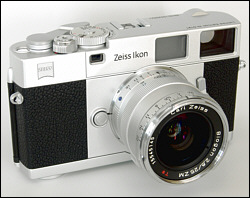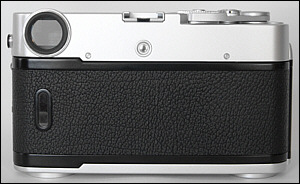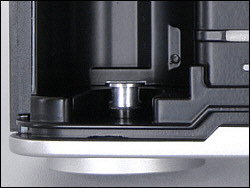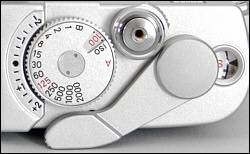 |
|
 |
||||||
|
|
|
|
|
|
|
|
||
 Looking good with the 25mm Biogon. |
Let me get right to the point. The more I handle the Zeiss Ikon, the more I like it.
The body has a nice solid feel to it. And some of the controls almost seem too easy to use.
I wrote on an Internet posting that Leica users might come away feeling disappointed with the camera, because the Zeiss Ikon doesn't have that heavy feel, which some equate with high quality. With the Zeiss Ikon, Carl Zeiss hopes to prove that you can produce a sturdy, durable, reliable camera that doesn't have to break your back. Time will prove whether Carl Zeiss has met its goal.
The top deck is fairly simple, just how I like cameras to be. There is the frame counter, the film advance lever, the shutter release with an on-off switch for the meter, the shutter speed dial and the hot shoe. The rewind crank is on the bottom plate.
 A clean top deck. Notice the bulge for the very large eyepiece, and you can really see just how large it is in this photo:  The small silver button below the hot shoe is the AE lock. Note the small window to allow the photographer to see the type of film that's been loaded -- a common feature these days. |
I'd like to see a Zeiss Ikon with a 135mm frame line, and this rangefinder would should be able to support one without difficulty. That, of course, would mean that I'd like to see Carl Zeiss produce a 135mm lens. That hasn't yet happened, but if it does, I vote for the 135mm Sonnar.
On the side is the latch that opens the back. You have to push the latch to the side and then up (in an "L" pattern), almost ensuring that you won't accidentally open the back and expose your film. Just above that is a standard PC socket for an electronic flash. It's in a nice location if you have the camera mounted to a flash bracket or if you're simply holding the flash off to the side.
The other side is simply the hinge. It's about the only Cosina styling cue, because the shape of the hinge is pure Cosina. I should stop right here and reinforce that this is not a Cosina camera. It's also not a rebadged Bessa. It's a Carl Zeiss design built by Cosina. There is some sharing of parts, but by and large this camera should not be considered a Cosina product.
The bottom has the rewind crank, the battery cover and the tripod socket, which is on the right side. It's decidedly old school. By the way, when you insert the battery, note that the (+) positive end should be facing down and the (–) negative side should be facing up when you replace the cover. The bottom plate looks to be plastic, but it's not. It's varnished magnesium, the same as the top plate. "Made in Japan" is stamped on the bottom in rather large type. I think something smaller would have been sufficient.
 Look, Ma., no foam in the back channels. No kidding. This came as a surprise, although I specifically checked the camera for it. OK, so I'm "different." |
I've always felt that foam was used to compensate for an inferior design. A properly designed back will block light. That's how it was since the early days of roll film, and that's how it should continue to be. I applaud Carl Zeiss for taking this step in the right direction.
Viewfinder and metering
As I've begun to use the Zeiss Ikon, I'm rapidly becoming very impressed with the viewfinder and the accuracy of the rangefinder system. The "quick throw" of the ZM lenses makes it very easy to follow a moving subject -- something that wasn't possible with the older Contax rangefinder, a camera that I really enjoy using. Even at distances that are well beyond 50 feet, minute movements of the focusing ring are reflected in the rangefinder patch. At those distances, depth of field even with the lens at f/2.0 will account for these minute changes.
One thing that is very important is positioning your eye correctly. And here the design of the camera is an aid. I have found that by placing the rounded edge of the camera near the middle inside of my nose, my eye is in the correct position to see the frame lines and to also see the shutter speeds. The upper left corner of the rubber on the eyepiece presses against my eyebrow. If your eye is not placed correctly, the rangefinder patch dims, and shutter speeds might not be visible. Each user will need to find a comfortable position that allows them to see the rangefinder patch, frame lines and shutter speed display.
 The shutter speed dial, film advance and other controls. Here, the collar is turned to the right, and the camera's electronics are off. No meter, and shutter won't fire. |
The shutter speeds are superimposed on the image, not in a blank area of the viewfinder. And that's because the viewfinder is so large that essentially there are no blank areas.
The shutter speed dial requires little effort to change; you can rotate it with an index finger or middle finger. The dial on some cameras is very stiff and requires you to use a finger and thumb, which means you have to take your finger away from the shutter release and your thumb from the film advance.
The shutter speed dial is much stiffer when set to "A," and that's a good indicator if you're in manual mode and switching shutter speed and the dial stiffens as you look through the viewfinder.
The shutter speed dial is rather flat and doesn't extend past the front of the camera, so there's no chance of accidentally changing your speeds. A nice design touch.
Partially depressing the shutter release turns the meter on for eight seconds. The collar that surrounds the shutter release also is an on-off switch. When the red dot appears, the camera is active. When the red dot is hidden, the camera is off. That's the entire camera, because this is an electronically controlled shutter with no manual speeds. It's wise to always carry a spare battery.
The shutter must be tensioned for you to be able to activate the meter. In other words, the camera is turned off if the shutter isn't tensioned.
In very bright light, the shutter speeds can be a bit hard to see, something to remember if you're shooting fast film outside.
Shooting automatic is simple. Turn the dial to "A" and shoot away. The selected speed appears on the left. The small chrome button that is centered on the back of the top deck allows the photographer to lock the exposure. That's useful for metering an area, locking exposure and then recomposing to shoot.
Exposure compensation is available by turning the "A" so it points to one of the positions to the left to intentionally underexpose or overexpose by up to two stops in one-third stop increments.
Real world photography
I've never been a test bench sort of guy. My bottom line is how the camera operates, and in this respect the camera has so far met and exceeded my expectations.
An example: The film advance lever is a short throw, a bit more than degrees. It's ratcheted, so it's possible to wind in short strokes if you want. Because the viewfinder is to the extreme left of the camera, it's very simple to advance the film and never move the camera from your eye. Not the first camera to be able to do this, and in the day of the auto-everything SLR, it's a feature that easily could have been overlooked.
The leather covering on the body is highly grippable. I'd still like to find a half case for the camera and would have been grateful if Carl Zeiss had included one. Alas, I'll have to go in search of one.
As I had mentioned before, the lens caps have dual points for removal, but the smaller inner grips should be angled in to make it easier to grab hold. And that's because our fingers are convex. Simple point, but something to think about for the future.
Construction of the new lenses appears to be very solid. The rear element of the 25mm Biogon extends further into the camera, which is expected. Serrated aperture and focusing rings are easy to grip.
In cold weather, the camera ... well, it's cold to hold in your bare hands, and a pair of gloves is highly recommended.
Shutter speed sounds
Think your shutter is too loud? Here's a small sampling of shutter sounds.
All were timed at 1/250, a speed that you might use outdoors. Not scientific
in any way, but a nice little way to compare the different cameras. These
are .WAV files. Selecting one of the names should launch the default media
player. You might have to use your keyboard's "Back" key to return to this
list. "Backspace" in Windows should do. Not sure what it is on a Mac.